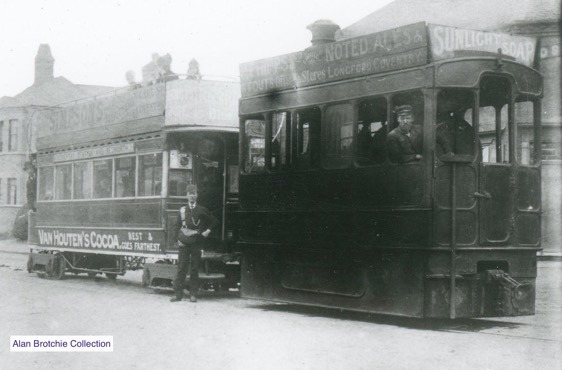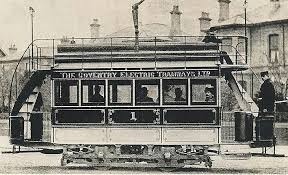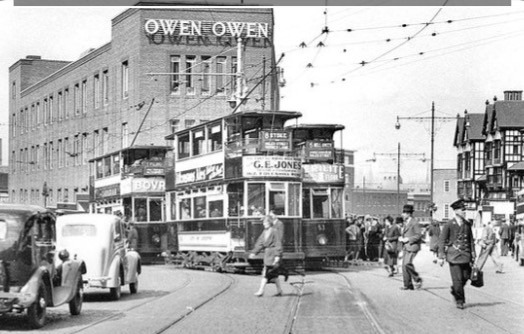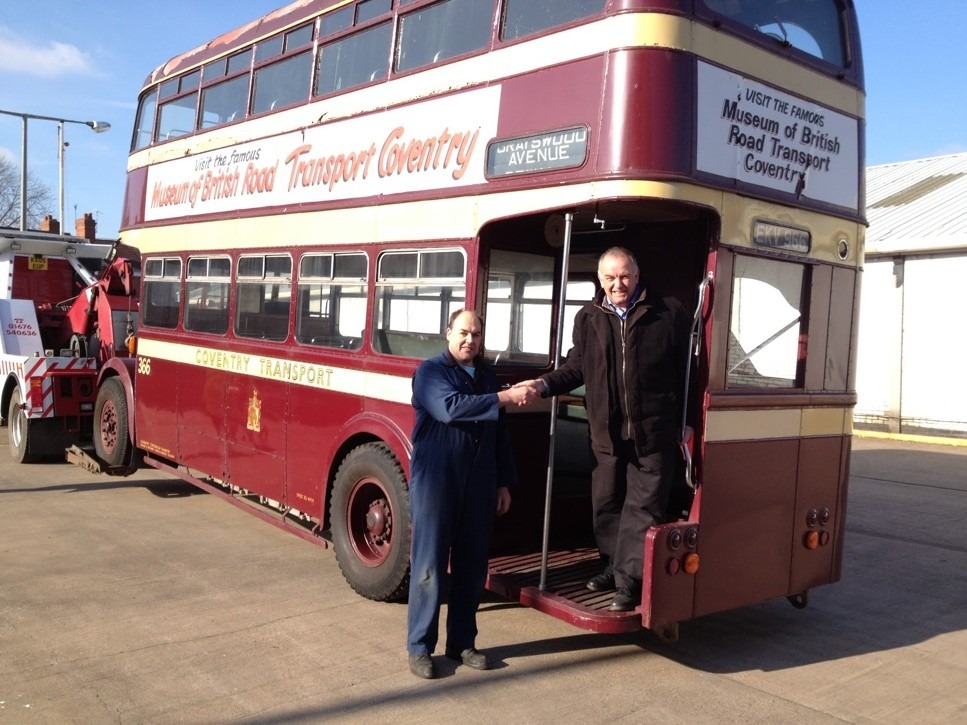Following the recent article about the trip on the Very Light Rail system, historian and CovSoc member, Peter James, tells us about the history of public transport in Coventry. Peter writes…..
Steam Trams 1884-1893
The first tram system in Coventry operated by the Coventry and District Tramways Company ran in 1884. It was authorised by a series of Acts of Parliament between 1880 and 1883.
Steam locomotives powered double decker trams on a 3 ft 6 ins wide track. The narrow gauge was necessary as some streets were not very wide making them difficult to negotiate. The first service ran from the railway station to Bedworth, a distance of 5.5 miles.
Steam trams were noisy, dirty due to the smoke and unreliable. One major problem was their inability to climb steep slopes, Bishop Street being a prime example. Insufficient passenger numbers eventually led to the closure in 1893.

Electric Trams 1895-1912
In December 1895 Coventry Electric Tramways Limited began running electric trams on the former steam tram lines. The first service was from Coventry to Foleshill and a week later this was extended to Bedworth. It utilised four double deck units with open tops. In 1897 the rail network grew with a line to Bell Green followed by a line to Stoke in 1899. Shortly afterwards in March 1900 a postal service was included which ran for forty years until the tramway ceased operation.

Coventry Corporation Tramways 1912-1940
The Coventry Electric Tramways Act of 1903 granted the city the right to purchase the tramway. However it was 1st January 1912 before the city took advantage and exercised this right. Coventry Corporation acquired 13 miles of track, 41 tramcars and two depots at Foleshill and Priestley’s Bridge. By 1926 there were three cross city tram routes in operation. A loop was added in that year from Greyfriars Green to Albany Road. By 1931 the tram fleet had expanded to a size of 73. Damage was caused during a number of air raids in October 1940. Repairs allowed some routes to resume service but the air raid of the 14th
November put an end to all services. In December 1940 the council decided to abandon the system. The last ever tram journey being in February 1941.

Motor Buses
On 30th March 1914 a service began using 6 motor buses made in Coventry by Maudslay. They were open top double deckers with 34 seats. The initial route was from the fire station in Hales Street to Stoke Heath. After the outbreak of war that year the buses were commandeered by the war office and the service was suspended. Services were resumed after the war in 1919 and a garage to accomodate buses was opened in Harnall Lane in 1921. During the 1920s double decker buses with covered tops and pneumatic tyres were introduced. The 1930s saw a collaboration with Daimler to develop lightweight all metal buses. Ronald Fearnley was General Manager from 1933 to 1962 and is credited with many of the innovations of this period.
Post-War Era
With the demise of the tram system the bus fleet was rebuilt and expanded after WW2.
Sandy Lane Garage was opened in 1954 and 8 foot wide buses were introduced. The number of services and vehicles increased and included coaches for private hire.

The picture of this bus with a rear entrance reminded me of an incident that occured when I was growing up in Chapelfields. In the mid Fifties my friends and I were on holiday from junior school. We decided to catch a bus into town and were standing at the Billing Road bus stop on Allesley Old Road. Three buses used to stop there, the number 1, number 10 and number 23. Geoff had his dog Mickey with him, it was a mongrel that looked a bit like a collie. A bus pulled in, someone got off then as the bus pulled away we noticed Mickey on the platform looking at us. We reckoned he’d jumped on the platform bounded up the stairs and got to the front of the upper deck before realising we weren’t with him. This wasn’t the bus we wanted! Luckily the dog had the sense to stay on the bus and not jump. He got off the bus at the Maudslay pub which was the next stop and raced back to join us. We thought it was hilarious.
Buses with a Single Operative
During the 1960s double decker buses appeared with entrance doors at the front opposite the driver. There was no longer a conductor and the engines were now at the rear of the bus. Daimler Fleetlines and Leyland Atlanteans became widely used on the network. Reduced passenger numbers and the increase in car ownership resulted in a number of route changes and more buses manned by just a driver.
On 1st April 1974 Coventry Corporation Transport was taken over by West Midlands Passenger Transport Executive. The maroon and cream livery disappeared eventually replaced by blue and cream of the Birmingham based company.
Today we have a fleet of electric buses that do most of the journeys and soon we may have a new light rail system – Coventry Very Light Rail (CVLR). This is currently being evaluated on a short length of track in the city centre. The 220 metre length runs from Greyfrars Green to Queen Victoria Road. This would be the first tram type network to run in the city since 1941.
